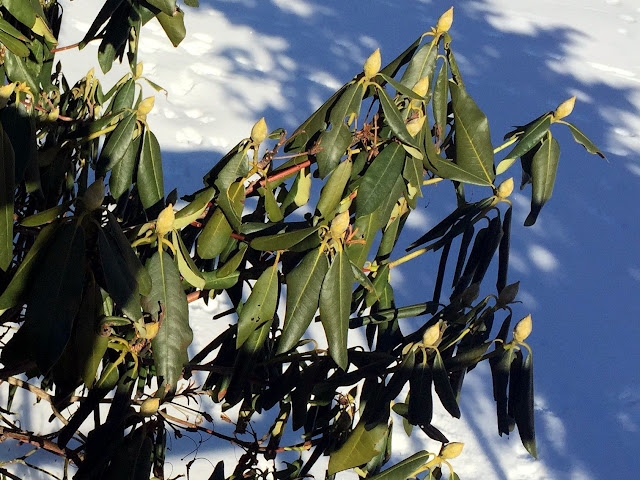We are at the darkest days of the
year. The woods can look pretty drab, and it even makes me appreciate
just a bit of snow to brighten the scenery. But take a walk and
look closely, and you will find some welcome color, red and green, to
greet you for the holidays.
Some different evergreens
We all know our pines, spruce, firs,
and cedars-the bigger evergreens of the woodlands. They provide
great protection for birds and other small creatures when the winter
winds blow and snows fall. Their cones hold nutritious seeds, high
in fats and proteins that the wildlife need to help them through the
cold season.
Look a little lower; the shrub layer
in many of our woodlands is dominated in places by our State Flower
Mountain Laurel( Kalmia latifolia). Drive along many of our roads
where the scenery is rocky and rough, and you will welcome the sight
of gnarled branches and leathery green leaves of this lovely shrub.
While it doesn’t provide a food supply, its usefulness as nesting
sites for forest birds is often revealed in winter.
In wetlands of some of the more
remote areas, our native rhododendron (R. maximum) will stand out,
green against the brown. During the severe cold, you can note that
rhododendron leaves droop downward and curl into tubes. This is the
plants’ adaptation to protect the leaf surface from cold and
dehydration in the dry winter air.
 |
|
Rhododendron
leaves droop and curl in winter.
|
Bright winter reds
Our native hollies provide winter
interest. Our native evergreen American holly, ( Ilex opaca) the
familiar Christmas decoration, has spikes on the leaves to deter
deer but the berries are feasted upon by many birds now and through
the winter, as long as they last. Robins, Thrushes, and Bluebirds, in
particular, will find a bush and claim it.
 |
| Native winter holy |
Our other native holly, Winterberry
(Ilex verticillata)is deciduous, but its berries glow red on bare
branches during this season. These berries often do not fully ripen
until they have been cold for a long time; then they actually ferment
and the birds love them. This is true of many berries that remain on
the bush through the winter- Viburnum and crab apple in particular.
Those birds know how to wait until the vintage is perfect.
 |
| Winterberry with Mantis egg case. |
Mosses for the season
Club Mosses
(Lycopodium sp.), such as Princess Pine and Ground Cedar ( they have
multiple common names), will populate the ground in patches. Years
ago they were harvested irresponsibly for Christmas decorations and
the populations were nearly decimated. Garden Clubs have protected
the species by refusing to pick it or sell decorations using the club
mosses.
Many other species of moss seem to
become more intensely emerald at this time of year. Sphagnum moss,
which holds the water in the wetlands, is more softly colored, but
look closely at the structure of each plant: miniature Christmas
trees.
 |
|
Emerald
green cushion moss brightens the landscape.
|
 |
| Ground Cedar is a clubmoss. |
There are a few evergreen plants,
still holding leaves-Christmas Fern for one, each ‘leaflet’ on a
frond has a “toe” creating a “stocking”. Partridgeberry is
a sweet vining plan with delicate evergreen leaves. The occasional
red berry remains on the plant as an invitation to a ‘Partridge’
who may favor the berries. Sadly our native partridge or quail, the
Bobwhite, is considered extirpated from Connecticut. Only to be
remembered in Christmas song, being in a Pear Tree!
Happy Holidays to all and enjoy the
winter woods.
 |
| On the Christmas Fern, each leaflet has a stocking toe. |
 |
| Partridge Berry. |





















